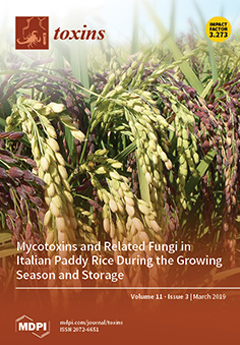Aflatoxin B
1 (AFB
1) is a serious threat to the poultry industry. Proanthocyanidins (PCs) demonstrates a broad range of biological, pharmacological, therapeutic, and chemoprotective properties. The aim of this study was to investigate the ameliorative effects of PCs against AFB
1-induced histopathology, oxidative stress, and apoptosis via the mitochondrial pathway in the bursa of Fabricius (BF) of broilers. One hundred forty-four one-day old Cobb chicks were randomly assigned into four treatment groups of six replicates (6 birds each replicate) for 28 days. Groups were fed on the following four diets; (1) Basal diet without addition of PCs or AFB
1 (Control); (2) basal diet supplemented with 1 mg/kg AFB
1 from contaminated corn (AFB
1); (3) basal diet supplemented with 250 mg/kg PCs (PCs); and (4) basal diet supplemented with 1 mg/kg AFB
1 + 250 mg/kg PCs (AFB
1+ PCs). The present study results showed that antioxidant enzymes activities of total superoxide dismutase (T-SOD), catalase (CAT), glutathione peroxidase (GSH-Px), and glutathione S-transferase (GST) in AFB
1 treated group were (
p < 0.05) decreased, whereas malondialdehyde (MDA) contents were significantly increased in comparison with the control group. Furthermore, we found that dietary PCs treatment ameliorated AFB
1-induced oxidative stress in the BF through inhibiting the accumulation of MDA content and enhancing the antioxidant enzymes activities (T-SOD, CAT, GSH-Px, and GST). Similarly, PCs markedly enhanced messenger RNA (mRNA) expression of antioxidant genes (
SOD,
CAT,
GPx1, and
GST) in comparison with AFB
1 group. Moreover, histological results showed that PCs alleviated AFB
1-induced apoptotic cells in the BF of broilers. In addition, both mRNA and protein expression results manifested that mitochondrial-apoptosis-associated genes (
Bax,
caspase-9,
caspase-3,
and p53 and cytochrome c) showed up-regulation, while (
Bcl-2) showed down-regulation in AFB
1 fed group. The supplementation of PCs to AFB
1 diet significantly reversed the mRNA and protein expression of these apoptosis-associated genes, as compared to the AFB
1 group. Our results demonstrated that PCs ameliorated AFB
1-induced oxidative stress by modulating the antioxidant defense system and apoptosis in the BF through mitochondrial pathway in broilers.
Full article






